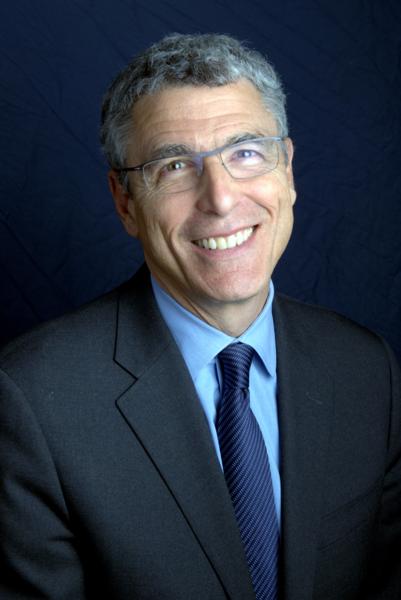Parashat T'ruma describes building a mishkan, a sacred space, and the first central praying place in Jewish life. People were asked to give both their skills and their material possessions to build it, and together they created something both beautiful and portable. Rabbi Rick Jacobs asks us to consider: how do we learn how to build our own sacred spaces? What makes a space sacred? How do we balance the tensions between a modest, spiritual space and humbling grandeur? How do we define the heart of a community? How do we define what's real?
Three ways to listen:
- Listen to the full podcast below
- Subscribe to the podcast on Apple Podcasts
- Suscribe to the RSS feed
Transcript
[URJ Intro:] Welcome back to "On the Other Hand: Ten Minutes of Torah," a podcast presented by ReformJudaism.org. Each week, Rabbi Rick Jacobs, the President of the Union for Reform Judaism, shares a new spin on the weekly Torah portion in about 10 minutes or less. This week Rabbi Jacobs teaches us about Parashat T'rumah. He asks, how do you achieve spiritual centeredness? Does it have to do with the place, or just with yourself? Or maybe both?
[Rabbi Rick Jacobs:] This week we focus our attention on Parashat T'rumah from the Book of Exodus. And it begins the parshiyot that focus on creating the first praying place in Jewish life. And amazingly it wasn't a fancy you know huge deal, it was a modest home-constructed, desert little space that we created. And the people bring forth their gifts -- both their actual skills in making, and the materials for the construction, and they create what is a beautiful, simple, portable praying space that they carry with them on the journey through the desert of Sinai.
When we think about it, we have this tension in Jewish life, because we've got a whole history of these modest prayer spaces, you know, maybe called a shul, or a beautiful little gem of a space, or maybe a little beit midrash, a house of study, where we do a little praying too. And then we also have these majestic structures. Think, for example, about the First and Second Temples. They were described in antiquity as being among the most gorgeous, elaborate, stunning physical sacred structures in the world. And how do you balance the small [and] modest with the grand transcendent beauty of some of these spaces? And I have to say we have a whole tradition -- we have a tradition of building. We also have this harvest booth -- remember the sukkah -- this little flimsy hut, where we remember what it was like to be modest desert wanderers. So we've got this internal tension.
And I have to say, in my recent travels, and I get to travel all the time, which is such a blessing to meet the communities and to see up close where they pray, what the community looks like, what the topography is. And in one week, I went from this beautiful, beautiful community in Calabasas, California, "Or Ami," literally "The Light of My People." And there they have a very beautiful community, and they have this, I would say, modest, very functional space. It's really in an office building, but they have a sanctuary, they've got meeting spaces -- and Oh my God, is that community alive. Rabbi Paul Kipnis and Rabbi Julia Wise are just so magnificently keeping it together. Remember, they had the fires recently, they had the shooting at the Borderline Cafe, and they have focused on how do you build community? And, OK, you need a physical place to do it. But the essence and the focus is the community.
Well, a few days later, I'm back in New York City, and I get to walk into Congregation Emmanuel on Fifth Avenue for their spectacular Martin Luther King Shabbat. And, oh my goodness, you talk about majestic space, that space just takes your breath away. It's so gorgeous. And on that particular Friday night, there's the Abyssinian Baptist Church and their pastor the Reverend Dr. Calvin Butts. And it's so alive and beautiful and spirited at the modest and small, [and] the majestic and large, but the ikar is the heart. What's the soul of a place?
So I just want to take a moment and think about the desert, little prayer space that our ancestors first constructed based on this parashah, Parashat T'rumah. And what I also find is for me -- I know, maybe for you as well -- spirituality is so powerful in nature. If I get to sit on a mountain, or near the water, and just take in the sky, and the clouds, and the breeze, and the trees, and the grasses, and all the smells, I honestly find that very spiritually uplifting and inspiring. So think of this desert [as] a praying place. It was carried around. It was constructed wherever they camped. And it also sat amidst the mountains, and the sand, and the tumbleweeds, and all the different natural places, and you could smell and feel nature all around you in that little prayer space. That, again, was made with their own hands and hearts.
So I love that there is a natural dimension to that space, and today it's a little harder. The Shulchan Aruch, the code of medieval Jewish law, has rules for everything, and they got rules for making synagogues. What are the things that you have to do? So one of the things, in the section called Orech Chayyim, in Chapter 9, it says "When possible, the synagogue should be built at the highest point of the town, and should be taller than any other inhabited building." While there's not [that] in the middle of the desert, with the Sinai mountains, and the, you know, the sand, and the shores of the Red Sea. But there is a beautiful teaching that the synagogue should be geographically on the highest place, but [also] morally, spiritually, an elevated place, a place that others can look to and aspire to. What a beautiful little dimension.
The Shulchan Aruch, Yosef Cairo's medieval code, also says "The leader faces the Ark." I just know as a rabbi in congregations for many, many years, something a little bit... [it's] sometimes awkward and challenging about facing a congregation as opposed to facing the ark. Who is leading? Where are we facing? What are we yearning for? There are all kinds of rules.
I like also that it says in here that, you know, there are certain rules to come in. And this is my favorite little passage in the Shulchan Aruch about coming into sacred spaces: "You shall not enter a holy place in the summer in order to find shelter from the heat, nor to find refuge from the rain." If you must enter to call out to somebody or to find a friend, you may enter, but you first got to do some spiritual business: recite a few verses of Scripture, study a Mishna, say a code from the ancient code of law, say a prayer, listen to some Torah words, or at least sit down and just be still and quiet. And then you can go about whatever business you have to transact.
I love this. It's not about architecture. It's not about the materials. It's about the sacred purpose. You enter a sacred space only with a sacred intention, and if you've got something really more business-like to transact, like you have to see your friend who you're working [with] on a project together, that's OK. But first, ground yourself. Recite a verse. Take a moment, and say a prayer. Sit quietly. Do something that reminds you not to be instrumental -- meaning using a place or a person to achieve something -- but simply ground yourself in that spirituality. So thinking about a little bit more of our travels. I love the way this ancient narrative about building sacred space, [and] some of the medieval rules for how do you create congregations where prayer and study are the elemental things?
And in the last couple of weeks, I've actually visited congregations celebrating their 175th anniversaries. That's a big deal. I mean, do the math with me. For a movement that was only created officially in 1873 by Isaac Mayer Wise, so celebrating 175 years of a congregation's life, that puts them before this. So I was privileged to be in Ohev Shalom in Norfolk, Virginia celebrating 175 years. God bless. Beautiful community, beautiful physical space and sense of purpose. Congregation Beth Israel in West Hartford -- also 175 years. And I want to wish a special mazel-tov to a congregation just having observed their 175th anniversary. Known as Springhill Avenue Temple, or also by the Hebrew name Shaarei Shamayim, in Mobile, Alabama just celebrated their 175th! Mazel tov! You can see that there is a whole community of congregations that are roughly of this age, and boy they have an amazing story to tell about our movement and Jewish life through the decades. And we also think about some of the quieter, smaller communities in the south. Think in particular about Dothan, Alabama, Temple Emmanuel, founded in 1929 -- a beautiful jewel in Alabama.
And, you know, it's just amazing as we read the Parashah T'rumah, some of us will be sitting in huge magnificent cathedral-like synagogues, some will be in modest prayer spaces, maybe even just an auditorium that's rented, and on a basic level it doesn't matter. What matters is what we bring to it, how we bring it alive.
If you're blessed to have a sanctuary that's dedicated for sacred purposes, that's great. If you're using, maybe even praying in a home, or maybe you do your own spiritual practice, you take a walk. As Shabbat expression, whatever it might be, I think T'rumah is saying [that] sacred spaces can be great, great catalysts to spiritual connection and growth and community. And it doesn't have to be fancy! It just has to be real.
So wherever you are, wherever you listen to the podcast, wherever you might be. Do what I do, which is everywhere I go, I try to find the beautiful, sacred spaces of my own tradition, but also of other traditions. I'm a junkie, and I go to the churches and the mosques and the Hindu temples. I love to see and feel what makes spaces have that dimension that we called kadosh, sacred. So T'rumah is grounding to us, reminds us that God is found in those holy places -- not because it's in the building. "Asu li mikdash, v'shachanti b'tocham." No, God is in those places because God can be in us, in community, and the holy work that we do together.
[URJ Outro:] Thanks for joining us for this week's episode of "On the Other Hand: Ten Minutes of Torah." If you liked what you heard today, and we hope you did, you can find new episodes each week at ReformJudaism.org, and on Apple Podcasts, where we would love for you to rate and review us. And you can visit ReformJudaism.org to learn more about all aspects of Judaism, including rituals, culture, holidays, and more. "On the Other Hand: Ten Minutes of Torah" is a project of the Union for Reform Judaism, a leading voice in the discussion of modern Jewish life. Until next week --l'hitraot!


 Apple
Apple Android
Android Stitcher
Stitcher